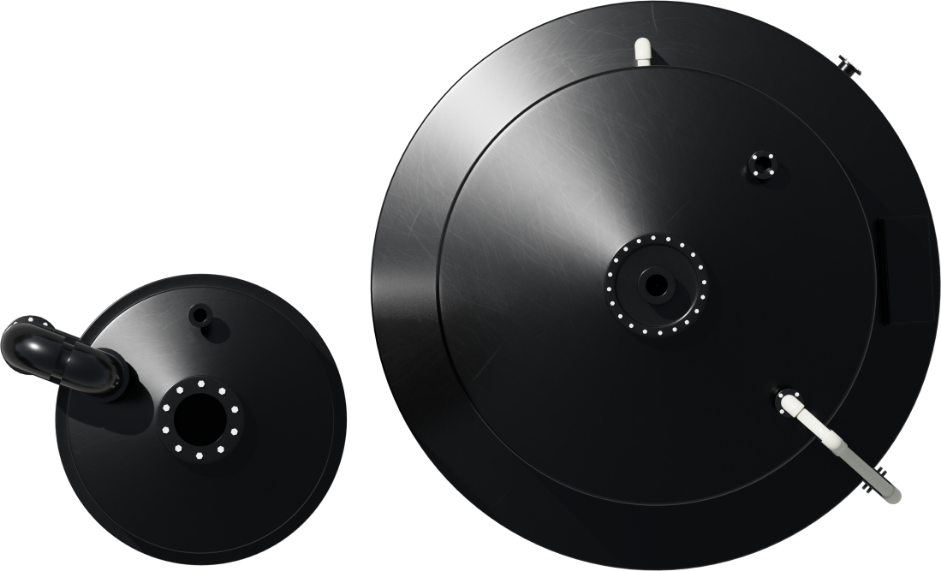SAFEBULK® from NIPLAST ® is a system of liquid chemical storage that provides secondary containment (also called bunding) to the primary chemical storage tank, but as an integral part of the same engineered product.
The primary NIPLAST® chemical storage tank is purchased with its own dedicated containment bund, the bund designed and constructed from the same corrosion resistant thermoplastic as specified for the tank. The bund is sized at 110% of the tank’s operating capacity and is designed to collect any tank overfill and protect the immediate environment from any spillage. SAFEBULK® systems accord with HSE guidelines on the bunding of tanks.
| Product Code | SB123456 |
| Material | THERMOPLASTIC 1N58C |
| Max Height | 16.4 Metres |
| Max Diameter | 32 Metres |
| Install Method | Built On Site |
| Max Pressure | 2.8 Bar / 40PSI |
| UV Rating | 100% @ UV9 |
| Commercial Warranty | 10 Year Materials & Labour |
The most common SAFEBULK® system format is akin to a cup and saucer, in that a cylindrical vertical NIPLAST® tank is centrally located within a wider diameter bund.
The SAFEBULK® approach precludes the need to construct a civil built bund and its site installation is greatly reduced by the pre-engineering undertaken by NIPLAST® before delivery.
SAFEBULK specifications typically cover all aspects of chemical storage, generally including: Fill-line for road tanker discharge; valved outlet line through bund wall; extension to visual level indicator to allow contents to be assessed outside the bund; access manways and inspection ports; bund breach alarms; frost protection systems, weather covers; ladders and other tank access hardware.
As with NIPLAST ® tanks, SAFEBULK® systems are designed and manufactured to the British and European Standard BS EN 12573 and also to the fore-running German specification DVS 2205, using only the highest quality component materials available.
NIPLAST ® SAFEBULK® systems are constructed from the highest rated welding technique within that design code, ie. the butt fusion of extruded thermoplastic plates. High precision automated butt fusion machine welds ensure build integrity over design lives of 20 years. Third party employee certification to EN 13067 by The Welding Institute (TWI) underwrites that build integrity.
Self-bunding storage tanks are a type of container used to safely store liquids that have the potential to cause environmental contamination. Also known as bunded tanks or chemical bunds, they are available in various bund capacity types. However, they all have an outer wall or ‘bund’ that surrounds the main storage tank. This creates a protective layer capable of containing leaks and spills which makes them perfect for storing hazardous substances.
The bunding effectively forms a built-in secondary containment system around the inner tank. It is typically constructed from durable, liquid-tight materials like plastic. The bund’s walls extend high enough to enclose the entire capacity of the inner tank. Most bunded tanks include leak detection systems as an added precaution especially because you cannot be too careful when trying to store or transport hazardous materials.
Self-bunding tanks provide security and peace of mind when storing large quantities of oils, chemicals, process waters or other hazardous fluids. The outer bund prevents leaks from spreading into the surrounding environment, avoiding pollution and flooding incidents. They adhere to stringent regulations for facilities managing dangerous substances. The in-built spill containment and monitoring, make self-bunding tanks an essential component for safe, responsible storage and handling of high-risk liquids.
While both are designed to safely contain liquids, traditional chemical storage tanks differ from bunding storage tanks in some key ways.
Chemical tanks are simple containers made from materials compatible with the stored substance or hazardous chemicals. They may be constructed from plastic, fiberglass, or other chemical-resistant materials. These tanks provide a sealed repository for fluids but have no secondary containment system or bund wall like a chemical bund tank. Any leaks or spills from the tank would spread and so the issue of contains lost product would need to be addressed in another way.
Bunding tanks feature an inner storage tank surrounded by an outer spill containment wall or ‘bund.’ This catchment area safely captures any leaks from the inner tank before they can reach the environment. Bunding essentially creates an integrated secondary containment system around single-walled chemical tanks.
The bund walls surrounding storage tanks serve the critical purpose of containing any leaked liquid to prevent environmental contamination. As such, they must be constructed from strong, impermeable materials resistant to the stored substances.
Common materials for bund walls include:
– Plastic: High-density polyethylene (HDPE) or other chemical-resistant plastics are lightweight, non-permeable bunding options. Plastic bunds are easy to install around existing tanks. Plus, they are comparatively affordable while offering a high level of protection.
– Composites: Fibreglass, carbon fibre, and other non-metallic composites offer high strength with chemical resistance. Epoxy coatings improve impermeability.
– Reinforced Concrete: Durable and non-permeable concrete is commonly used for tank bunding. The concrete can also be lined or coated.
Proper construction and sealing of bund walls are critical to contain spills. Thus, by choosing suitable robust, impenetrable materials, bunds safely and reliably prevent leaks from migrating beyond the tank’s confines into the surrounding environment.
With over 40 years of brand heritage, Niplast are experts in manufacturing plastic bulk storage tanks to strict CEN standard BS EN 12573 and its forerunner DVS 2205.
Our long history of applying these standards innovatively to solve chemical storage problems our clients meet, is what sets us apart. Sometimes you need to think outside of the tank
Today, with over 40 years of brand heritage, Niplast is an expert in manufacturing plastic bulk storage tanks or industrial tanks to strict CEN standard BS EN 12573 and its forerunner DVS 2205.
Our long history of innovatively applying these standards to solve chemical storage problems sets us apart from other brands of underground water tanks and chemical storage solutions. Sometimes, you need to think outside of the tank!
Contact Us